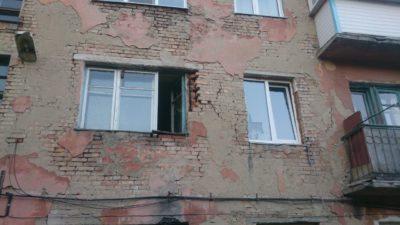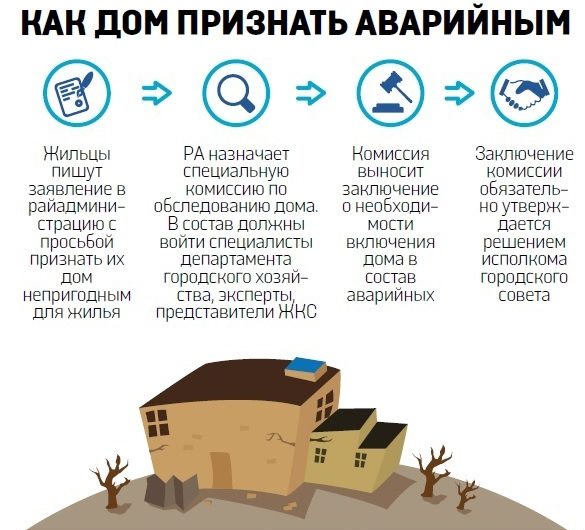When is a house considered unsafe or dilapidated?
Content
The grounds for recognizing an apartment building as unsafe are specified in Decree of the Government of the Russian Federation of January 28, 2006 No. 47.
When a house is considered unsafe:
- Inconsistency with sanitary and hygienic requirements, background radiation levels, sources of vibration, noise, and electromagnetic fields.
- Destruction, damage, deformation of supporting structures, if there is a danger of collapse.
- Damage or destruction of a house as a result of a man-made or other accident.
A house may also be declared uninhabitable if it is located in a hazardous area. For example, in areas of probable destruction during accidents, landslides, avalanches, mudflows, or in areas that are regularly flooded by flood waters, if flooding cannot be prevented using technology.
Note: housing is not simply recognized as unsafe. It is extremely important that the commission gives an opinion that even major repairs will not eliminate the shortcomings. If it is possible to simply carry out major repairs, no one will be resettled.
Dilapidated and emergency housing: what is the difference
It is necessary to distinguish between the concepts of dilapidated and emergency housing.
Dilapidated houses are called houses with worn-out structures of individual elements or buildings as a whole, if operational standards go beyond those established by state standards. Depending on the design features, the following wear and tear percentages are established, upon reaching which a house is considered dilapidated:
- stone buildings - 70% or more;
- wooden - from 65%.
A house is considered unsafe if the technical condition of any elements of the supporting structures poses a danger to the integrity of the building - in case of excess deformation, damage or wear of elements, with the need for subsequent strengthening.
If in a building more than fifty percent of the premises and load-bearing elements of building structures are assigned an emergency category, they are recognized as dangerous for people. Such objects cannot be strengthened or restored. They are subject to dismantling, with preliminary resettlement of residents.
Unlike emergency ones, dilapidated houses, although they do not meet the standards, do not pose a risk of collapse.
Who participates in the resettlement program?
According to the law on the resettlement of emergency housing, the following categories of citizens can participate in the program:
- Apartment owners. They may receive other apartments or monetary compensation.
- Tenants under social tenancy agreements. They are provided with other housing with similar parameters.
If the apartment was rented out to tenants, the rental agreement is terminated from the moment the housing is recognized as unsafe. The owner does not have any obligations to them, but must return the money for the remaining days. He is not obliged to provide other housing.
How is the market value of dilapidated housing determined?
One of the possible solutions for owners of dilapidated housing within the framework of the resettlement program is the allocation of monetary compensation in the amount of available living space at current market prices.
The procedure for determining the redemption value of living space is established by Part 7 of Art. 32 of the RF Housing Code and takes into account the following factors:
- market price of the apartment;
- material costs incurred by the owner due to the purchase of the premises;
- expenses for moving, searching for and arranging alternative living space;
- owner's expenses related to the termination of long-term obligations, including compensation for lost profits.
If the owner does not agree with the assessment of living space, he has the right to challenge its results in court. It is possible to independently search for an apartment to move to, with reimbursement of the cost of this living space as part of compensation for the old one.
The possibility of shared participation of the municipality with the drawing up of a social tenancy agreement is also allowed if the allocated compensation is not enough to purchase a new apartment.
Where do they move from emergency housing?
As part of the resettlement program, residents of dilapidated houses are offered equivalent apartments that are built specifically for them and meet all the requirements:
- By area.
- By location.
- By number of rooms.
It is important that housing conditions are not deteriorated as a result of relocation.
If a person lives in a dilapidated house under a social tenancy agreement, he is also provided with equivalent housing, but the number of rooms may be different. The main thing is that it meets the requirements for area (clause 37 of the Resolution of the Plenum of the Supreme Court of the Russian Federation of July 2, 2009 No. 14).
Note: instead of a new apartment, you can submit an application to receive the redemption value of emergency housing. It is calculated taking into account market prices minus actual wear and tear. This method is not very profitable, because in the end the owner will receive pennies with which he cannot buy another property.
Relocation of residents from dilapidated and dilapidated houses
If it is decided that the house is subject to resettlement, it is included in the list of dilapidated housing that falls under the program. If there is an immediate danger to residents, temporary premises are allocated until a replacement apartment is found.
Procedure and timing of relocation
The list of buildings for resettlement for the next five-year period has already been compiled. Therefore, you should not hope for the allocation of living space before 2024 if the apartment is not included in the lists. A possible solution is to receive monetary compensation or provide a preferential mortgage loan if the local municipality is insufficiently financially secure within the framework of this program.
Relocation is carried out according to the established queue. Extraordinary allocation of living space is provided for those living in dilapidated buildings affected by a natural disaster or fire, subject to a corresponding court order.
Applicants for relocation are given three options from which they must choose one. After this, the owner enters into an agreement with the municipality to change the living space. The procedure for registering a new apartment and moving takes about six months.
How many square meters are required?
When relocating from dilapidated housing, owners are required by law to be provided with equivalent living space. If a family needs to increase square meters according to social norms, the authorities should take this circumstance into account.
Is it possible to refuse resettlement?
Sometimes owners of dilapidated housing refuse to be relocated under the program. This is due to the following circumstances:
- allocation of living space in areas with insufficiently developed infrastructure - in the absence of shops, schools and preschool institutions, etc.;
- provision of apartments that do not match the size or level of amenities of the old ones;
- location of premises on higher floors. This reason is especially relevant for older people, young mothers, and citizens with physical disabilities.
Read also: Help for small businesses in 2020
Residents have the right to refuse if they are not satisfied with the new apartment, demanding payment of monetary compensation. If resettlers are not satisfied with any options, including monetary payment, local authorities, in order not to disrupt the resettlement program, can use the appropriate court decision. The basis for the adoption of this decision of the judicial authorities is the residence of citizens in unsafe houses, with the danger of structural collapse.
The procedure for relocating owners from emergency housing
The procedure for relocating from dilapidated or emergency housing consists of several stages. First you need to submit an application to the interdepartmental commission. Usually its functions are performed by the housing inspectorate under the municipal administration. After this, an examination is carried out, a conclusion is drawn up and a decision is made.
Let's look at each stage in detail.
Step 1: Apply
The owner, HOA, tenant, state housing supervision have the right to submit an application to recognize the house as unsafe. Before doing this, they need to contact an independent expert who will inspect the housing, identify all the shortcomings and reflect them in the conclusion. From 2020 this is mandatory. Then the assessment of the condition of the housing is carried out again, but with the participation of a commission.
Documentation
When contacting the interdepartmental commission you will need:
- statement;
- passport;
- an extract from the Unified State Register confirming ownership;
- floor plan of the house;
- expert opinion.
Note! If complaints about the unsatisfactory condition of the house were previously filed with the management company or HOA, it is advisable to submit copies of them along with other documents.

Sample application
Step 2: conducting an examination
During the review of documents, the interdepartmental commission determines the composition of the experts to be involved and organizes work to assess the suitability or unsuitability of a residential building for permanent residence.
During the examination, an apartment building is examined, and a conclusion is drawn up based on the results.
Step 3: document review
The submitted documents along with the conclusion are reviewed by the administration within one month. If the house was damaged as a result of an emergency, the time frame is reduced to 20 days. Additional information from other government agencies is requested through the interdepartmental interaction system.
Step 4: Decide
The decision based on the conclusion is made by a majority vote of the commission, drawn up in triplicate. One of them is sent to the applicant. If the number of votes is equal, the vote of the chairman of the commission is considered decisive. When making decisions, representatives of other bodies may be involved: urban planning, architecture, experts.
30 days are given to make a decision from the date of receipt of the conclusion. If the house was damaged as a result of an accident – 20 days.
Important! If the house is less than 5 years old, the decision and conclusion are sent to the prosecutor’s office to consider whether to hold the developer accountable.
Step 5: Queuing
When a house is declared unsafe, information about the owners is transferred to a government agency to be placed on a waiting list for housing. It can last several years; each region has different settlement periods.
○ Procedure for relocation and receipt of compensation.
Before demolition is carried out, all citizens must be resettled in other houses. The premises provided to replace the old one must be equivalent, that is, the area and number of rooms must be at least no less. Housing conditions must be improved compared to an emergency apartment. Apartments are provided either on the basis of ownership or under a social tenancy agreement, depending on what powers the citizen had in relation to the old housing.
However, regional authorities can provide citizens living in municipal apartments with premises on the right of ownership, if the subject’s budget can afford it. For example, this procedure is provided for by the renovation program in Moscow.
Citizens who receive ownership of apartments must register the right to residential premises with the territorial bodies of Rosreestr. For this, in accordance with the provisions of Federal Law No. 218-FZ dated July 13, 2015 “On State Registration of Real Estate,” the following package of documents is required:
- A document certifying ownership. It is issued by the authorities of the subject or municipality.
- Passport of the citizen in whose name the property is registered.
If a social rental agreement is concluded, registration with the Unified State Register is not required. The timing of resettlement is established by regional programs depending on the region’s availability of funds and housing stock. Registration of ownership should take no more than 5 days.
- Part 9 of Article 16 of the Federal Law “On the Fund for Assistance to Housing and Communal Services Reform”:
- “State registration of the emergence and transfer of ownership of residential premises, which are provided to citizens in accordance with this Federal Law, is carried out within no more than five working days from the date of filing the application and the documents necessary for such state registration.”
In case of refusal to provide housing, citizens may demand payment of monetary compensation. To do this, an application is submitted to the body responsible for the implementation of resettlement, which justifies the reason for abandoning the apartment, and also attaches a document certifying ownership. Compensation is calculated from the market value of the residential premises that the authorities planned to provide instead of the damaged one.
Owner's rights when relocating dilapidated housing
Owners of apartments located in dilapidated buildings have the following rights:
- Move to other housing in the same localities. For example, if the apartment being demolished is in the city, they cannot send the person to the village.
- Get a larger property if you are registered as needy.
- Receive the purchase price of the demolished housing instead of a new apartment.
Legal advice: if the administration insists on relocating to a less developed area, it is worth challenging this order in court. The deterioration of living conditions should not be allowed, but many people forget about this.
What is considered equivalent housing?
Owners of emergency and dilapidated housing, according to this program, must receive equivalent housing (what to do if the housing is recognized as unsafe?). What does equivalent mean? This is housing that is located in the same locality and even in the same administrative district (to other areas - only with the written consent of the residents). You also need to know that the following requirements must be met by law :
- the new housing must have water, electricity, gas, a stove and plumbing must also be installed;
- At least 18 square meters must be allocated for each registered person;
- residents cannot be moved to communal apartments;
- those who were in line to improve their living conditions should receive an apartment or house taking into account the missing space;
- Residents of communal apartments receive separate apartments; moving into communal apartments is again illegal.
Important! Owners should receive housing, not monetary compensation.
Money can be issued only at the request of the tenant , formalized in a written application. The application is reviewed by the municipal service and may be rejected.
Judicial practice on the relocation of owners from dilapidated housing
Most often, courts consider cases of challenging the purchase price or collecting compensation instead of providing other apartments. The administration may refer to the lack of money in the budget, but the courts do not always side with the defendants.
Here are some examples of such decisions in real cases:
- Decision No. 2-2110/2019 2-2110/2019~M-931/2019 M-931/2019 dated September 18, 2020 in case No. 2-2110/2019.
- Decision No. 2-427/2019 2-9/2020 2-9/2020(2-427/2019;)~M-361/2019 M-361/2019 dated February 6, 2020 in case No. 2-427/2019 .
- Decision No. 2-265/2020 2-265/2020(2-6959/2019;)~M-6323/2019 2-6959/2019 M-6323/2019 dated January 22, 2020 in case No. 2-265/2020 .
○ Advice from a lawyer:
✔ Can you count on relocation from dilapidated housing?
The status of dilapidated and dilapidated housing is currently the same, and the first concept is included in the second. However, in some regional acts you can find similar names for houses. Many citizens also understand dilapidated housing as a building that is subject to reconstruction rather than demolition.
Regarding such housing, Art. 32 of the Housing Code of the Russian Federation provides for temporary resettlement in connection with the seizure of the land plot on which the house is located for state and municipal needs. During repair and restoration work, citizens are provided with apartments from the so-called maneuverable fund on a free basis.
✔ What if you don’t agree to relocation?
Recognizing a house as unsafe involves the eviction of all residents, since living in it poses a threat to human life and health. Citizens who do not agree to resettlement can count on receiving compensation in monetary terms. If they refuse to voluntarily leave the apartment, they are subject to forced eviction with the provision of temporary housing from the regional or municipal fund.
Video
What is “emergency” housing, how does it differ from dilapidated housing? Who can determine for sure whether your home is in disrepair? Where to go and what documents to collect? This will be discussed in the program “Housing and Communal Services from A to Z” on the OTR channel.
Published by: Vadim Kalyuzhny , specialist of the TopYurist.RU portal
Lawyer's answers to private questions
Is it legal for the administration to demolish a dilapidated house at the expense of the owners?
Yes. According to Part 4 of Art. 32 of the Housing Code of the Russian Federation, the requirement for the demolition of a house within a reasonable time is presented to the owners by the administration. If this requirement is not met, the dilapidated house along with the land underneath it is confiscated for municipal needs.
What are the rules for the reform of relocation from emergency housing in Moscow?
The resettlement program in the capital is carried out in accordance with Law No. 14 of May 17, 2017 “On additional guarantees...”. There are stricter requirements for new apartments than in other regions. For example, you cannot issue an apartment with a smaller area or with fewer rooms. Real estate is issued in the same areas where dilapidated houses are located and meets city improvement standards.
I live in the same apartment with my ex-husband and son, we each have ½ ownership. The house was declared unsafe. Can they give us two apartments so we can move apart?
No, they won’t give you two apartments. Only one, equivalent in terms of requirements.
The house was destroyed as a result of a domestic gas explosion and cannot be restored. Is the administration obliged to provide temporary housing to residents?
Yes, I must. Usually people are resettled in communal apartments or temporary accommodation centers, and then apartments are allocated.
How to check if a house is recognized as unsafe?
You can view the list of houses recognized as unsafe and subject to resettlement on the local administration website. Such lists are publicly available.
Grounds for declaring a house unfit for habitation
A house may be declared unfit for habitation if the following defects and damage to building structures and other deficiencies are noted:
- deformations of foundations and foundations that cannot be restored;
- lack of energy communications - water supply, electrical wiring, etc.;
- the premises are located in a place that may suffer from a probable man-made disaster;
- the structure is seriously damaged as a result of a natural disaster, natural disaster or fire, beyond the impossibility of restoration;
- the building is not connected to a centralized heating system, with individual heating of individual apartments;
- the apartments do not have windows, so the level of illumination in the rooms does not correspond to the standards established by the standards;
- the content of harmful and toxic substances in the premises is exceeded, which is dangerous to life and is in conflict with legal requirements.
If at least one of the noted features is true for a building, it is subject to demolition, and the people registered there are subject to a program for relocation from dilapidated and dilapidated housing.

Grounds for declaring a house unfit for habitation
Residence and registration in this living space
There are no problems registering in housing that is recognized as unsafe. This is confirmed by Federal Law-5242-1 of June 25. There are simply no rules prohibiting doing this. In fact, registration is sometimes refused because members of the local administration have already included it in the list of unfit for habitation.
They will be able to register in a new place where the administration will resettle them. New living space is not provided immediately, is it delayed? They don’t register and don’t allow you to live in it, citing a resolution of the municipal government? You can appeal this decision in court. Emergency living quarters cannot be privatized. This norm is reflected in Art. 4 Federal Law-1541-1 dated July 4, 1991
The nuances of living and registering in emergency and dilapidated housing are described in a separate article.
What to do if the house is demolished?
If the owner finds himself in a situation where an apartment or house has been declared unsafe, he should know that the administration can buy it out. If they come to an agreement, he can move to the option offered to him. It will reflect the value of the appraised property, terms and other conditions of redemption.
If you disagree with the decision or if a situation develops where the parties do not reach an agreement, the administration or the owner may file a lawsuit in court. It is presented within 2 years from the date of receipt of notification of the decision to seize.

In Russia, the practice continues when some areas with dilapidated buildings are not of interest to investor-developers. They are inhabited by tenants who are waiting for the day when the administration will resettle them at public expense. When they no longer expect, investors suddenly appear. Residents have to rush to the Housing Committee to submit documents for privatization (read about registration of ownership of emergency non-privatized housing here). In this case, the compensation can be substantial, since the owner can request a larger living space in the new location.
Sometimes the resettlement process lasts for years , since one of the owners does not agree with the amount of compensation or the area of the apartment in return. As a result, the investor may abandon the problem house, and all the residents will remain in their shacks.
Documents accompanying the procedure
The owner, tenant or employees of the State Housing Inspectorate can submit an application to recognize the living space as dilapidated. He is included in the interdepartmental commission for his area, which always works under the administration or at the location of the housing.
In addition to the application for emergency housing, it is important to provide copies of the following documents:
- Certificate of ownership or document confirming social rent. All title documents are photocopied.
- Plan and technical certificate for housing.
- Conclusion from independent experts from a specialized organization.
- If there are complaints from residents confirming the unsatisfactory living conditions.
Redemption price
In the process of relocating residents from dilapidated and dilapidated houses, regional authorities must fulfill one of the following responsibilities:
- Pay the tenant (former owner) the redemption price of his home.
- Provide a new apartment, including the cost of dilapidated housing in the redemption price.
The size of the redemption price depends on the current value of the property on the market. Again, it is installed by the municipal authorities.
There are quite a lot of cases when city authorities deliberately want to reduce the purchase price of housing, arguing that it is in dilapidated condition, underdeveloped nearby infrastructure, or other vague expressions.
If the inhabitant of a dilapidated or dilapidated apartment does not agree with the redemption price of the apartment, he has the right to seek help from the court. But according to the law, legal proceedings must begin no later than two years after the city authorities make a corresponding decision to relocate a citizen (and his family) from a dilapidated or dilapidated home.
Complex legal ambiguities associated with dilapidated and dilapidated housing are determined by the fact that housing legislation is supplemented by many local acts. This often leads to misunderstanding or incomplete understanding of the resettlement process by some citizens. Therefore, to clarify all difficult points, it is advisable to seek advice from experienced lawyers.
We hope that we have clarified your view of emergency (dilapidated) housing a little: what it is, what are its features, what is its difference and similarity with emergency housing.
Author of the article: Petr Romanovsky, lawyer Work experience 15 years, specialization - housing, family, inheritance, land, criminal cases.
Useful information on housing issues
- Major repairs Carrying out major repairs
- Court decisions on major repairs of apartment buildings
- Types of work on major repairs of apartment buildings
- Major renovation of residential buildings
- Refusal to overhaul an apartment building
- The procedure for carrying out major repairs of an apartment building
- Complaint about major renovation of an apartment building
- Illegal redevelopment
- Sale of an apartment after privatization
- If your apartment is flooded due to the fault of housing and communal services
- Eviction of a non-owner
- Interdepartmental commission for recognizing housing as unsafe
Demolition or reconstruction
If, during an inspection, a residential premises is found to be in disrepair and unfit for habitation, then, depending on the degree of damage, the building may be dismantled or a range of works may be carried out to improve the condition. In the first scenario, residents are provided with a new place to live with the transfer of ownership, or financial compensation is allocated for the purchase. In the second case, residents are temporarily relocated while the work is being carried out.
“Demolition is not carried out immediately, but after a certain time, which is why there is a program where such buildings are included. The exception is cases when residential premises are considered dangerous to the life and health of citizens.”
The procedure is carried out by regional authorities after a tender is held, as a result of which a company is selected. Afterwards, an agreement is drawn up, which specifies the methods, deadlines, and requirements. Residents are settled in advance and things are transported. Communications and adjacent property are removed, and then demolition begins.
Documentation
To relocate, residents of dilapidated and dilapidated housing will need the following documents:
- A written statement from the tenant about the improper condition of the house.
- Resolution of the local authority.
- Documents for ownership of the apartment from which you need to move out.
- Certificate of registration of ownership (in the territorial department of Rosreestr).
- An act confirming the technical examination of wear and tear.
- Project for reconstruction of premises (if it is necessary to recognize non-residential premises as residential).
- Floor plan of an emergency or dilapidated apartment building.
- Other documents (at the discretion of the applicant).
Where can I find out about the timing and procedure for relocation?
Many apartment owners do not know whether their house is included in the list for resettlement? And if included, when can we expect to move into new buildings? The answers can be found on the official website of the body responsible for the resettlement – the Housing and Communal Services Reform Fund at https://www.reformagkh.ru in the “ Resettlement of Citizens ” section.
The resettlement schedule and information about houses are published on the websites of locality administrations. Information can also be found in local media. If you are interested in a specific house, you can look for a sign on its facade - usually there is a text there about the timing and procedure for occupancy of the building.
What you can find out on the federal portal “Housing and Utilities Reform”:
- resettlement statistics for the period of the program in Russia;
- search for your home by address - for homeowners and tenants;
- list of objects for resettlement - for each region;
- information about the technical characteristics of buildings, inspections carried out, deficiencies found and their impact;
- timing of relocation of residents;
- information on resettlement mechanisms, contracts with developers, transportation services;
- data on houses that are being built to resettle people from emergency housing for liquidation;
- data on the reserve housing stock of municipalities and the state.
If the owners do not find their home on the list for resettlement, they can submit an online request directly on the Housing and Communal Services Reform website. Specialists will accept your request and provide an answer.
So, the new Program for resettlement from dilapidated and dilapidated houses is designed for 2019-2026. Innovations are related to subsidies, social mortgages, resettlement of houses in rural areas and targeted programs in the regions. Most likely, in the future the program will become indefinite.
Still have questions? Ask them to the lawyers of our portal. Relocation is considered a rather complicated procedure. Often, authorities infringe on the rights of owners, for example, by providing a smaller apartment. It happens that the house is in disrepair, but is not included in the list for resettlement. Then you need to make an application to the interdepartmental commission of the municipality. The lawyer will tell you what to pay attention to, what to include in the application, how to achieve a fair allocation of living space or calculate compensation for the demolition of the building. Acting alone, you risk being left homeless or waiting in line for relocation for many, many years.
We recommend a video about the nuances of relocating from emergency housing under the new 2020 program:
Attention!
- Due to frequent changes in legislation, information sometimes becomes outdated faster than we can update it on the website.
- All cases are very individual and depend on many factors. Basic information does not guarantee a solution to your specific problems.
That's why FREE expert consultants work for you around the clock!
- via the form (below), or via online chat
- Call the hotline:
- Moscow and the Region
- St. Petersburg and region
- FREE for a lawyer!

By submitting data you agree to the Consent to PD Processing, PD Processing Policy and User Agreement.
Anonymously
Information about you will not be disclosed
Fast
Fill out the form and a lawyer will contact you within 5 minutes
Tell your friends
Rate ( 1 ratings, average: 5.00 out of 5)
Author of the article
Maxim Privalov
Lawyer. 2 years of experience. I specialize in civil disputes in the field of housing and family law.
Author's rating
Articles written
610
How is a building recognized as dilapidated?

- physical deterioration of the building. Its reliability, strength and stability are at risk;
- change in the microclimate in the home. It is impossible to comply with the necessary sanitary and epidemiological requirements and standards regarding hygiene;
- damage due to natural disasters and man-made factors.
Attention! In each of the above cases, relocation occurs no later than 48 hours from the moment the living space is recognized as dilapidated.
How to recognize a house as dilapidated
Documents for the house (apartment) are collected and submitted to the municipality. Afterwards assessment activities are carried out. A residential building is included in the list of dilapidated buildings in the following cases:
- Wear of structures of brick and stone houses is more than 70%.
- More than half of the houses and attics made of wood built in pre-war times are worn out.

The difference between the dilapidation of a building and the accident rate is that an outdated building does not pose a direct danger to citizens, there is no risk of collapse, it is characterized by a high percentage of reduction in the strength of the materials of the structural elements of the structure and does not imply resettlement.
What are the advantages of a dilapidated house?
Dilapidated houses have only one advantage compared to dilapidated ones: they do not pose a threat to the lives of the owners. Despite their general condition, they won’t collapse right now, so there’s no need to worry about it.
However, there is also a significant drawback. For example, residents of dilapidated houses do not have the opportunity to get another apartment in a more or less new building for free. Also, they are not entitled to monetary compensation from the state.
Example: In some cases, immediately after a house is declared unsafe, residents are given 1-2 days to urgently move out. This happens quite rarely and only in cases where such an emergency house can really collapse at any minute. Residents of dilapidated houses do not have this problem. Even when their structure is recognized as unsafe, most likely the relocation period will be longer: from several weeks to several months.
Demolition
Houses are subject to demolition by decision of authorized bodies in the following cases:
- When citizens apply for recognition of housing as dilapidated and subsequent demolition, in this case a commission meets and a decision is made on the need for demolition.
- When the government program planned the liquidation of the building.
Regions of the Russian Federation have their own resettlement and demolition programs. As a general rule, buildings that were officially declared dilapidated before 2012 are subject to priority demolition.
To demolish a building, it is necessary to obtain an official order, which is issued after a decision on demolition is made by a collegial body - a commission. Demolition occurs in stages: the main structures of the building are destroyed by mechanical force, and at the end of the process the remaining parts of the building collapse.
In exceptional cases, the main structures of the building are preserved, since they can be used to construct a new premises.








